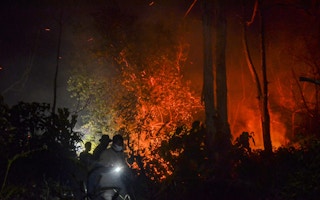Favourable weather conditions point to a less severe forest fire season in Indonesia this year, but the burning could still compound what is now the worst coronavirus situation of any country, experts say.
However, as the country is battling a second wave of coronavirus infections and entering the dry season at the same time, Indonesia couldn’t afford to rest on its laurels, experts warn.
Official data show that fires burned 35,271 hectares (87,157 acres) of land from January to May 2021, a 9 per cent decrease from the same period in 2020. But fires are expected to increase as the country enters the dry season.
“Indeed, from August until October, and even November, that’s the peak [of the dry season],” Basar Manullang, the director of fire mitigation at the Ministry of Environment and Forestry, said in a recent webinar. “From August to October, we need to be extra cautious and focus on land and forest fire mitigation.”
The risk of forest fires and their resulting haze, which typically sicken hundreds of thousands of people every year, is especially worrying this time around as Indonesia reels from a devastating second wave of Covid-19 that has made the country the global epicenter of the pandemic. Daily infection rates and deaths continue to rise, leaving hospitals overwhelmed and oxygen and medicine scarce.
The confirmed total death toll in the country has surpassed 74,000, the highest in Asia, bar India.
Experts say the onset of the fire season, and the smoke generated, will stretch the country’s medical facilities beyond their limits and send the nation into a catastrophic health crisis. Agus Dwi Susanto, who chairs the Indonesian Society of Pulmonologists (PDPI), said smog from forest fires could exacerbate respiratory complaints from the Covid-19 outbreak.
“Research has shown that exposure to air pollution, including [from] land and forest fires, could exacerbate the symptoms of Covid-19,” he said.
He added that even before the pandemic, haze from forest fires could cause a fourfold increase in cases of upper respiratory tract infections in the hardest-hit regions.
The double blow of a smog-related infection and Covid-19 would compound the symptoms in affected people, requiring greater rates of hospitalisation in a system that the Indonesian Medical Association (IDI) says has already “functionally collapsed.”
“Exposure of lungs to particulate matter changes the immune response of the cells in lungs, which increases oxidative stress and inflammation,” Agus said.
That makes it more important than ever to prevent the fires this time around, experts say.
“If we don’t want to get the impact of an increase in Covid-19 cases caused by air pollution, then let’s prevent [fires] together and don’t let [fires] become a facilitator of Covid-19,” said Bambang Hero Saharjo, a forest fire expert from the Bogor Institute of Agriculture (IPB).
Less risk of haze
Tempering the threat of a worsening health crisis is the expectation that this year’s fires will be weaker than in previous years.
A new report by the Singapore Institute of International Affairs (SIIA) shows there’s a low risk of severe transboundary haze — smoke from fires in Sumatra blowing across the Malacca Strait to Singapore and Malaysia, and even as far as Thailand — during the dry season this year.
This is the first time the SIIA, a think tank, has made such a projection since it began publishing its annual outlook report in 2019. It cited a number of reasons for the lower haze risk.
For one, this year’s dry season is expected to be normal, with Indonesia’s meteorological agency, the BMKG, predicting a slightly later start to the dry season for much of the region, including parts of Sumatra and Kalimantan, the Indonesian portion of the island of Borneo.
Both regions are home to large swaths of highly flammable and carbon-rich peatlands, which farmers typically burn at the start of the dry season to prepare for planting.
“Of course dry season is coming up, but it’s not a severe dry season,” Simon Tay, the SIIA chairman, said at the launch of the report. “So it’s relatively benign.”
And since this year’s weather will not be extreme, the actual risk of haze from fires in Indonesia will depend to a large extent on forest and peatland management policies in the country, as well as human behaviour, according to the report.
In terms of policy, Tay said the government had taken positive steps to mitigate future fires. He cited the government’s peatland restoration initiatives, which were supposed to end last year but were renewed by President Joko Widodo through to 2024. The agency tasked to spearhead the initiatives also saw its mandate expanded to include the rehabilitation of mangroves.
The agency is now called the Peatland and Mangrove Restoration Agency, or BRGM.
“The extension of BRGM is positive, and the renewal will deepen the commitment,” Tay said. “Not only that, we see the coordination across the government improved significantly.”
Peat restoration
Peatlands have been the focus of the country’s fire prevention and mitigation efforts in recent years after unbridled clearing and draining of the landscapes rendered the ecosystems easily flammable. Once they start burning, the fires are virtually inextinguishable until the rains set in.
The burning of peatlands also releases huge volumes of greenhouse gases into the atmosphere. Land use change, including from forest fires, is the leading driver of GHG emissions in Indonesia, which in turn is one of the world’s biggest emitters.
While fires in the first five months of 2021 have burned less land than last year, they have scorched a larger proportion of peatland, up 20 per cent from last year: nearly 19,000 hectares (47,000 acres) of peatland burned between January and May this year, compared to 15,756 hectares (38,934 acres) during the same period in 2020, according to official data.
The SIIA report pointed out that the peat restoration agency’s effectiveness had been questioned by some of the NGOs and experts interviewed by the think tank. Despite the government’s claim that nearly 4.5 million hectares (11 million acres) of degraded peatlands had been rehabilitated by the end of 2020, NGOs and experts said the government figures can’t be verified due to lack of transparency.
There are even indications that the total restored area is smaller than what the government claims.
“
This report’s findings show that the government’s current efforts to protect peatlands are not effective at preventing them from burning.
Greenpeace
A recent analysis by Greenpeace shows that repeated fires have occurred in the priority peatland restoration areas, with around 936,000 hectares (2.3 million acres acres) of peat burned in these priority areas.
However, the SIIA report noted that the renewal of the peat restoration agency’s mandate meant it had the opportunity to continue its job. Greenpeace, meanwhile, called for extra attention to companies with responsibilities for restoring the peat areas on their concessions, since the presence of large-scale plantations has greatly limited peat restoration attempts.
“This report’s findings show that the government’s current efforts to protect peatlands are not effective at preventing them from burning, as there are still many concessions and companies operating inside peatland hydrological units which continue to degrade their hydrological function by maintaining and extending canals, lowering the water table and expanding land clearance,” Greenpeace said in its report.
Companies’ role in the burning
While the SIIA said there’s no elevated risk of fires and haze in 2021 from policy factors, there are a number of policy changes recently introduced by the government that could increase haze risk in the future.
Among them is a recently passed slate of deregulation, known as the omnibus law on job creation, which strips away layers of environmental protection measures established to date in the name of national economic recovery and attracting investment.
“[The omnibus law] tries to cut red tape so that there’s less restriction and obstacles for investors,” Tay said. “This is a priority. But on the flip side, there are some concerns raised [about the] regulatory process.”
For example, the new law scraps a requirement that all regions in Indonesia maintain a minimum 30 per cent of their watershed and/or island area as forest area. Scrapping this, environmentalists say, will encourage even greater deforestation.
Businesses may also be subject to less stringent requirements for environmental impact assessments when applying for licenses, and it may be harder to hold companies liable for fires on their concessions under the new law.
“This could lead to some issues where there’d be a return of some of the worst practices,” Tay said. “This is particularly because the agricultural sector is facing commodity price rises.”
In its report, the SIIA noted that the pandemic had resulted in a surge in prices across agricultural commodity markets, including palm oil and other tropical commodities produced in Indonesia.
The price of palm oil in particular has been driven up due to supply shortages for other vegetable oils produced elsewhere in the world. There are concerns that this price rise will drive greater deforestation and fires from the expansion of the plantation industry in Indonesia, the world’s top producer of palm oil.
“
We know that land and forest fires happen because of land clearing for plantation activities. Nearly 70 per cent [of fires] break out in plantations.
Anggia Erma Rini, member of parliament, National Awakening Party (PKB)
A recent study by researchers from technology company TheTreeMap and other institutions found that the rates of plantation expansion and forest loss correlated with palm oil prices. However, the study suggests that any link is gradually diminishing, with price surges being followed by smaller amounts of tree cover loss over time.
Therefore, the SIIA said, the issue is a complex one and it’s not clear whether the recent price increase will lead to more deforestation, and subsequently forest fires, or not.
“Will this lead to more deforestation? That’s very hard to say,” SIIA senior assistant director Aaron Choo said. “Others have advised that under the current economic situation, maybe nobody will want to expand. So maybe there’ll be no burning to clear land.”
But the concerns are still there, he added.
“What we are concerned about is fires created by commercial actors,” Choo said. “And I think the trouble is of course there’s a leakage market in Indonesia and the region.”
He said the greatest risk of fires comes from small and medium-sized companies. This is because they typically don’t participate in international certification schemes, resulting in weaker oversight of their activities.
“Medium-sized but still commercial-scale or national-scale actors are difficult to police,” Choo said. “[And corporate] ownerships are hard to track down even with the Indonesian government.”
Lawmakers have also highlighted the responsibilities that plantation companies bear for the annual forest fires. During a recent parliamentary hearing, lawmaker Anggia Erma Rini from the National Awakening Party (PKB) said plantation expansion played a huge role in the recurring fires.
“We know that land and forest fires happen because of land clearing for plantation activities,” she said. “Nearly 70 per cent [of fires] break out in plantations.”
Darori Wonodipuro, a lawmaker with the Gerindra Party, questioned what plantation companies had been doing to mitigate fires on their concessions.
“The ones with many fires are plantations. What are the companies’ role? Are they [just] watching [their concessions burn]?” he said. “Companies should have played an active role, such as sharing the cost to rent firefighting helicopters. It looks like all [the cost of fighting fires] is being borne by the government.”
This story was published with permission from Mongabay.com.





















